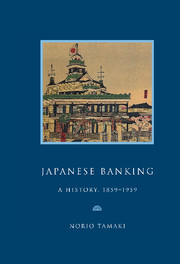Book contents
- Frontmatter
- Contents
- Preface
- Genealogy of leading Japanese banks, 1859–1959
- List of abbreviations
- Map
- Part I A bankrupt Shogunate, 1859–1868
- Part II The Meiji Restoration: monetary confusion and banking experiments, 1868–1881
- Part III Matsukata, the wizard of Japanese banking, 1881–1897; the Yokohama Specie Bank (1880) and the Bank of Japan (1882)
- Part IV The Japanese on the London money market, 1897–1911
- Historical background
- 13 The ‘Siamese twins’: Nichigin and Shokin, 1897–1911
- 14 Special banking, 1897–1911
- 15 Banking at the end of the Meiji era, 1900–1911
- 16 Banking and the securities market, 1897–1911
- Part V War, the Japanese boom years, 1911–1919
- Part VI Crisis and the road to war, 1919–1937
- Part VII Complete commitment, struggle and defeat, 1937–1945
- Part VIII American ‘democratisation’ and the search for growth, 1945–1959
- An extraordinary century, 1859–1959
- Appendices
- Notes
- Bibliography
- Index
13 - The ‘Siamese twins’: Nichigin and Shokin, 1897–1911
Published online by Cambridge University Press: 03 February 2010
- Frontmatter
- Contents
- Preface
- Genealogy of leading Japanese banks, 1859–1959
- List of abbreviations
- Map
- Part I A bankrupt Shogunate, 1859–1868
- Part II The Meiji Restoration: monetary confusion and banking experiments, 1868–1881
- Part III Matsukata, the wizard of Japanese banking, 1881–1897; the Yokohama Specie Bank (1880) and the Bank of Japan (1882)
- Part IV The Japanese on the London money market, 1897–1911
- Historical background
- 13 The ‘Siamese twins’: Nichigin and Shokin, 1897–1911
- 14 Special banking, 1897–1911
- 15 Banking at the end of the Meiji era, 1900–1911
- 16 Banking and the securities market, 1897–1911
- Part V War, the Japanese boom years, 1911–1919
- Part VI Crisis and the road to war, 1919–1937
- Part VII Complete commitment, struggle and defeat, 1937–1945
- Part VIII American ‘democratisation’ and the search for growth, 1945–1959
- An extraordinary century, 1859–1959
- Appendices
- Notes
- Bibliography
- Index
Summary
The Bank of Japan and its monetary policies, 1897–1911
While Nichigin (the Bank of Japan) was engaged in working successfully towards the gold standard, it was criticised for failing to redistribute fairly the profits resulting from the privileged fiduciary issues of banknotes. Following the publication of a critical article in Tokyo Keizaizasshi, or Tokyo Economist, several officials of the Ministry of Finance, bank associations and newly elected Diet members all echoed the same cry. Throughout the 1890s the question of the redistribution of the Bank of Japan's profits remained hotly disputed especially in the Diet. In the mean time the Bank tried to demonstrate its ability to serve the nation by extending its branch network to Nagoya, Fukushima, Hiroshima and Kanazawa, making by 1909 nine branches in all. In 1899 it was decided, and enacted into law, that the Bank of Japan should pay a tax at the rate of 1.25 per cent, which rate remained the same until 1923, on outstanding fiduciary note issues. In exchange the Bank was to be allowed to increase the limit of their excessive issue from ¥85 to ¥120 million.
The 1897 proposal by Bank of Japan officials to the Finance Minister on central banking received a negative response from the Ministry but Matsukata's replies as Finance Minister well illustrate the sorts of measures the Ministry were using for their monetary policies. Above all they utilised the facilities of special discounting of bills covered by specified brands of shares and stocks listed on the Stock Exchanges.
- Type
- Chapter
- Information
- Japanese BankingA History, 1859–1959, pp. 90 - 97Publisher: Cambridge University PressPrint publication year: 1995



